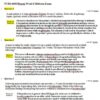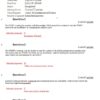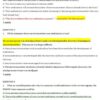Description
NURS 6630 Final Exam Psychopharmacology – Question and Answers
- The PMHNP understands that slow-dose extended-release stimulants are most appropriate for which patients with ADHD?
- Jordan is diagnosed with obsessive compulsive disorder. He has been trialed on several different SSRIs and is currently on high dose sertraline. He reports an inability to carry out responsibilities because of an obsession with handwashing. Which is the best treatment option for Jordan?
- The PMHNP is discussing dopamine D2 receptor occupancy and its association with aggressive behaviors in patients with the student. Why does the PMHNP prescribe a standard dose of atypical antipsychotics?
- A 72-year-old male patient is in the early stages of Alzheimer’s disease. The PMHNP determines that improving memory is a key consideration in selecting a medication. Which of the following would be an appropriate choice?
- A 71-year-old male patient comes to an appointment with his 65-year-old wife. They are both having concerns related to her memory and ability to recognize faces. The PMNHP is considering prescribing memantine (Namenda) based on the following symptoms:
- The PMHNP is working with the student to care for a patient with diabetic peripheral neuropathic pain. The student asks the PMHNP why SSRIs are not consistently useful in treating this particular patient’s pain. What is the best response by the PMHNP?
- The PMHNP is caring for a patient who openly admitted to drinking a quart of vodka daily. Prior to prescribing this patient disulfiram (Antabuse), it is important for the PMHNP to:
- The PMHNP is meeting with the parents of an 8-year-old patient who is receiving an initial prescription for D-amphetamine. The-PMHNP demonstrates appropriate prescribing practices when she prescribes the following dose:
- The PMHNP is assessing a patient who will be receiving phentermine + topiramate combination (QSYMIA). QSYMIA would be contraindicated in which patient?
- Jacob is a 7-year-old pediatric patient who has significant oppositional symptoms associated with his ADHD diagnosis. What is the best treatment for this patient?
- The PMHNP is attempting to treat a patient’s chronic pain by having the agent bind the open channel conformation of VSCCs to block those channels with a “use-dependent” form of inhibition. Which agent will the PMHNP most likely select?
- An adult patient presents with a history of alcohol addiction and attention deficit hyperactivity disorder (ADHD). Given these comorbidities, the PMHNP determines which of the following medications may be the best treatment option?
- The PMHNP prescribes gabapentin (Neurontin) for a patient’s chronic pain. How does the PMHNP anticipate the drug to work?
- A PMHNP supervisor is discussing with a nursing student how stimulants and noradrenergic agents assist with ADHD symptoms. What is the appropriate response?
- Kevin is an adolescent who has been diagnosed with kleptomania. His parents are interested in seeking pharmacological treatment. What does the PMHNP tell the parents regarding his treatment options?
- The PMHNP is caring for a patient with chronic insomnia. The PMHNP wishes to prescribe a drug with an ultra-short half-life. Which drug will the PMHNP prescribe?
- The parents of a 10 year old girl diagnosed with ADHD ask if the PMHNP can prescribe something to help their daughter’s ADHD that is not a stimulant. Which of the following responses is correct?
- Parents of a 12-year-old boy want to consider attention deficit hyperactivity disorder (ADHD) medication for their son. Which medication would the PMHNP start?
- The PMHNP is performing a quality assurance peer review of the chart of another PMHNP. Upon review, the PMHNP reviews the chart of an older adult patient in long-term care facility who has chronic insomnia. The chart indicates that the patient has been receiving hypnotics on a nightly basis. What does the PMHNP find problematic about this documentation?
- The PMHNP evaluates a patient presenting with symptoms of dementia. Before the PMHNP considers treatment options, the patient must be assessed for other possible causes of dementia.
- Which of the following answers addresses both possible other causes of dementia and a rational treatment option for Dementia?
- A patient calls the clinic to ask about an over-the-counter sleep aid. What is the best response?
- The PMHNP prescribed a patient lamotrigine (Lamictal), 25 mg by mouth daily, for nerve pain 6 months ago. The patient suddenly presents to the office with the complaint that the medication is no longer working and complains of increased pain. What action will the PMHNP most likely take?
- An 8-year-old patient presents with severe hyperactivity, described as “ants in his pants.” Based on self-report from the patient, his parents, and his teacher; attention deficit hyperactivity disorder (ADHD) is suspected. What medication is the PMNHP most likely to prescribe?
- Which patient will receive a lower dose of guanfacine?
- Which of the following is a true statement regarding the use of stimulants to treat attention deficit hyperactivity disorder (ADHD)?
- A patient with gambling disorder and no other psychiatric comorbidities is being treated with pharmacological agents. Which drug is the PMHNP most likely to prescribe?
- An interneuron is a neuron that has its cell body, dendrites, and axon within the spinal cord. The neuron can be considered excitatory if it contains ____________ or inhibitory if it contains ____________.
- The PMHNP is caring for a patient with chronic insomnia who is worried about pharmacological treatment because the patient does not want to experience dependence.
- Which pharmacological treatment approach will the PMHNP likely select for this patient for a limited duration, while searching and correcting the underlying pathology associated with the insomnia?
- A patient is being prescribed bupropion and is concerned about the side effects. What will the PMHNP tell the patient regarding bupropion?
- The PMHNP wishes to prescribe a medication that reduces glutamate transmission in an Alzheimer’s patient. Which medication should the PMHNP prescribe?
- A 43-year-old male patient is seeking clarification about treating attention deficit hyperactivity disorder (ADHD) in adults and how it differs from treating children, since his son is on medication to treat ADHD. The PMHNP conveys a major difference is which of the following?
- Karen completes the Epworth sleepiness scale and scores abnormally high. She is diagnosed with narcolepsy. The PMHNP prescribes a wake-promoting agent that is a weak dopamine transporter antagonist. Which medication did the PMHNP prescribe?
- The PMHNP is assessing a 49-year-old male with a history of depression, post-traumatic stress disorder (PTSD), alcoholism with malnutrition, diabetes mellitus type 2, and hypertension. His physical assessment is unremarkable with the exception of peripheral edema bilaterally to his lower extremities and a chief complaint of pain with numbness and tingling to each leg 5/10.
- The PMHNP starts this patient on a low dose of doxepin (Sinequan). What is the next action that must be taken by the PMHNP?
- The PMHNP is assessing a patient who has expressed suicidal intent and is now stating that he is hearing voices and sees people chasing him. The PMHNP identifies these symptoms to be associated with which of the following?
- Which of these statements is correct? (NURS 6630 Final Exam)
- A patient addicted to heroin is receiving treatment for detoxification. He begins to experience tachycardia, tremors, and diaphoresis. What medication will the PMHNP prescribe for this patient?
- A nursing student asks the PMHNP about the difference between the use of stimulants in the treatment of ADHD and the abuse of stimulants in substance-use disorders. Which is the correct response?
- A patient diagnosed with obsessive compulsive disorder has been taking a high-dose SSRI and is participating in therapy twice a week. He reports an inability to carry out responsibilities due to consistent interferences of his obsessions and compulsions. The PMHNP knows that the next step would be which of the following?
- You have been consulted to evaluate a patient who presents with symptoms of dementia. The patient is experiencing memory deficit, aphasia, apraxia, and agnosia.
- Which treatment option is best for this patient? (NURS 6630 Final Exam)
- A 26-year-old female patient with nicotine dependence and a history of anxiety presents with symptoms of attention deficit hyperactivity disorder (ADHD). Based on the assessment, what does the PMHNP consider?
- Why does the PMHNP avoid prescribing clozapine (Clozaril) as a first-line treatment to the patient with psychosis and aggression?
- The PMHNP is caring for a patient with fibromyalgia. Which second-line treatment does the PMHNP select that may be effective for managing this patient’s pain?
- The PMHNP understands that varenicline (CHANTIX) is an effective way to assist patients with smoking cessation. Why is this medication effective for these patients?
- A nursing students asks the PMHNP the difference between impulsivity and compulsivity. Which of the following responses is correct?
- The PMHNP is assessing a patient who presents with elevated levels of brain amyloid as noted by positron emission tomography (PET). What other factors will the PMHNP consider before prescribing medication for this patient, and what medication would the PMHNP want to avoid given these other factors?
- A patient addicted to heroin is receiving treatment for detoxification. He begins to experience autonomic hyperactivity during the drug withdrawal period. What medication will the PMHNP prescribe for this patient?
- Which of these characteristics does NOT meet the criteria for probably Alzheimer’s dementia?
- The PMHNP is assessing a female patient who has been taking lamotrigine (Lamictal) for migraine prophylaxis. After discovering that the patient has reached the maximum dose of this medication, the PMHNP decides to change the patient’s medication to zonisamide (Zonegran). In addition to evaluating this patient’s day-to-day activities, what should the PMHNP ensure that this patient understands?
- Even though both of these medications are useful in the treatment of ADHD, their actions are different. Atomoxetine is a selective ______________________ reuptake inhibitor, while bupropion is a selective __________________ reuptake inhibitor.
- A patient with irritable bowel syndrome reports chronic stomach pain. The PMHNP wants to prescribe the patient an agent that will cause irrelevant nociceptive inputs from the pain to be ignored and no longer perceived as painful. Which drug will the PMHNP prescribe?
- The PMHNP is teaching a patient with a sleep disorder about taking diphenhydramine (Benadryl). The patient is concerned about the side effects of the drug. What can the PMHNP teach the patient about this treatment approach?
- The PMHNP wants to prescribe Mr. Barber a mood stabilizer that will target aggressive and impulsive symptoms by decreasing dopaminergic neurotransmission. Which mood stabilizer will the PMHNP select? (NURS 6630 Final Exam)
- A group of nursing students seeks further clarification from the PMHNP on how cholinesterase inhibitors are beneficial for Alzheimer’s disease patients. What is the appropriate response?
- The PMHNP prescribes an obese patient phentermine (Adipex-p)/topiramate ER (Topamax) (Qsymia), Why is topiramate (Topamax) often prescribe with phentermine (Adipex-P)?
- The PMHNP is treating a patient for fibromyalgia and is considering prescribing milnacipran (Savella). When prescribing this medication, which action is the PMHNP likely to choose?
- An opioid-naive patient is taking MS Contin (morphine sulfate) to treat his pain that is secondary to cancer. Under what circumstances would the PMHNP order naloxone (Narcan) IM/SQ?
- The PMHNP prescribes pregabalin (LYRICA) for a patient with chronic pain. How does pregabalin work to reduce pain?
- All drugs that lead to addiction increase __________________in the ventral striatum, which is also call the _______________.
- The novel neurotransmitter adenosine is responsible for the sleep-wake cycle by increasing throughout the day and diminishing during night. Which of the follow is an antagonist of adenosine?
- A patient presents with psychotic aggression. Which treatment option is best for a patient presenting with psychotic aggression due to impaired top-down cortical control and excessive drive from striatal hyperactivity?
- Mrs. Rosen is a 49-year-old patient who is experiencing fibro-fog. What does the PMHNP prescribe for Mrs. Rosen to improve this condition?
- Naltrexone (Revia), an opioid antagonist, is a medication that is used for which of the following conditions?
- Sandra complains of constipation after being on quetiapine (SEROQUEL) for several weeks. Constipation is likely cause by the binding of quetiapine (SEROQUEL) to which receptor? (NURS 6630 Final Exam)
- Neal is complaining of restless leg syndrome and insomnia. Which first-line medication should the PMHNP prescribe to treat both?
- A 9-year-old female patient presents with symptoms of both attention deficit hyperactivity disorder (ADHD) and oppositional defiant disorder. In evaluating her symptoms, the PMHNP determines that which of the following medications may be beneficial in augmenting stimulant medication?
- The PMHNP has been asked to provide an in-service training to include attention to the use of antipsychotics to treat Alzheimer’s. What does the PMHNP convey to staff?
- A 75-year-old male patient diagnosed with Alzheimer’s disease presents with agitation and aggressive behavior. The PMHNP determines which of the following to be the best treatment option?
- A patient on chronic opioids is currently on oxycodone ER (OxyContin). The PMHNP is consult to treat underlying depression. Under which circumstance should the PMHNP order naloxone (NARCAN)?
- A 63-year-old patient presents with the following symptoms. The PMHNP determines which set of symptoms warrant prescribing a medication? Select the answer that is matched with an appropriate treatment.
- The PMHNP is evaluating a 30-year-old female patient who states that she notices pain and a drastic change in mood before the start of her menstrual cycle. The patient states that she has tried diet and lifestyle changes but nothing has worked. What will the PMHNP most likely do?
- Harold complains of pain associated with his irritable bowel syndrome with constipation. The PMHNP decides to prescribe a medication that prevents pain signals from reaching the brain. Which agent does the PMHNP prescribe?
- Brandon is a non-compliant patient that presents to the clinic asking for help with his alcohol dependence. The PMHNP evaluates the patient and determines a long-acting injection that blocks the mu-receptors would be the best treatment option for Brandon. Which medication should the PMHNP prescribe?
- Mr. Peterson is meeting with the PMHNP to discuss healthier dietary habits. With a BMI of 33, Mr. Peterson is obese and needs to modify his food intake. “Sometimes I think I’m addict to food the way some people are addicted to drugs,” he says. Which statement best describes the neurobiological parallels between food and drug addiction? (NURS 6630 Final Exam)
- The nursing staff asks the PMHNP for additional education regarding the treatment of agitation in dementia patients. Which of the following is correct?
- The PMHNP is teaching parents about their child’s new prescription for Ritalin. What will the PMHNP include in the teaching?
- Check out our latest courses on PSYC 502 Week 3.





